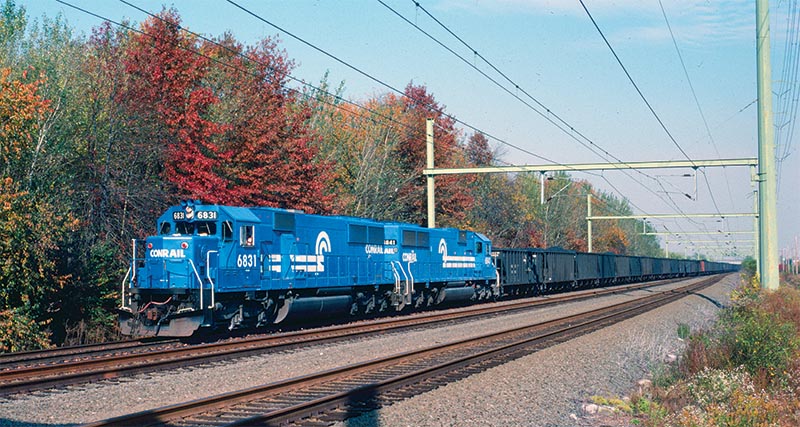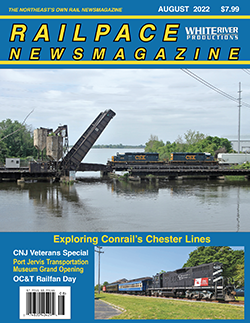 by Olev Taremae and Richard W. Jahn/photos as noted
by Olev Taremae and Richard W. Jahn/photos as noted
Proximity to the Delaware River waterfront and the City of Philadelphia made the area between the City and the Delaware state line a prime location for industrial development in the second half of the 18th and the first half of the 19th centuries. The area became packed with heavy industrial plants and related facilities. The Baldwin Locomotive Works in Eddystone would be one industry most familiar to railroad enthusiasts. This feature story explores the history of the lines now operated as the Chester Secondary and Chester Industrial Track, and operations by Conrail Shared Assets Operations (CSAO).
History
Wilmington, Del., to Philadelphia, Pa., main line of Pennsylvania Railroad (PRR) predecessor Philadelphia, Wilmington & Baltimore Railroad (PW&B) completed its route in 1838 on a right-of-way now used for parts of the Chester Secondary. The PW&B then completed its “Darby Improvement” in 1871. That line became the main route, and has since evolved into today’s Northeast Corridor, leaving the original line primarily serving local needs. The PRR identified the line that is today’s Chester Secondary as the Chester & Philadelphia, listed among the “other tracks” in its employee timetables. In the 20th century, PRR accessed the line with connections off the Washington- to-Philadelphia Main Line at Hook Tower in Marcus Hook, and in Eddystone.
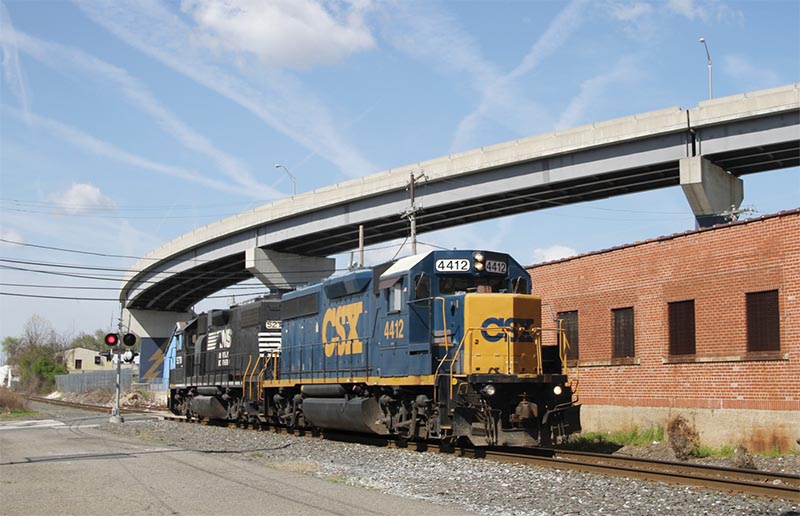
ABOVE: The northbound pair of CSX GP40-2 4412 and Norfolk Southern GP38-2 5278 pass under the approach ramps of the Commodore Barry Bridge in Chester, Pa., April 22, 2022. The engines are running light at this point. —Olev Taremae
The Reading Company’s (Reading) access to the area was less direct. Reading relied on trackage rights over the Baltimore & Ohio Railroad’s East End Subdivision between Park Junction and Eastwick interlocking. Reading identified its line as the Philadelphia & Chester Branch in 1941. By 1974, the Reading had renamed the line the Chester Creek Branch. Darby Creek, a location immediately east of the Darby Creek, was the Reading’s operations center and featured an engine terminal and yard.
The PRR and Reading ran side-by-side in the area, often within a stone’s throw of each other. A Reading Company map last revised from 1941 shows that the two railroads each maintained their own lines. Shared tracks existed only near the bridge crossing Chester Creek in Chester. PRR and Reading operated side-by side-yards at Stoney Creek in Trainer, south of Chester.
With all of the industries to be served, the area was swarming with railroad activity. A crew board, shown on opposite page, bottom) shows that the Reading carded eight locals in addition to two road trains serving the branch. From Darby Creek, one road train ran to Allentown, and the other to Harrisburg, hauling cars to and from the branch.
According to Reading’s 1965 Freight Service Guide, the railroad served 96 customers along the line; 12 in Essington, 11 in Eddystone and 73 in the Marcus Hook area.
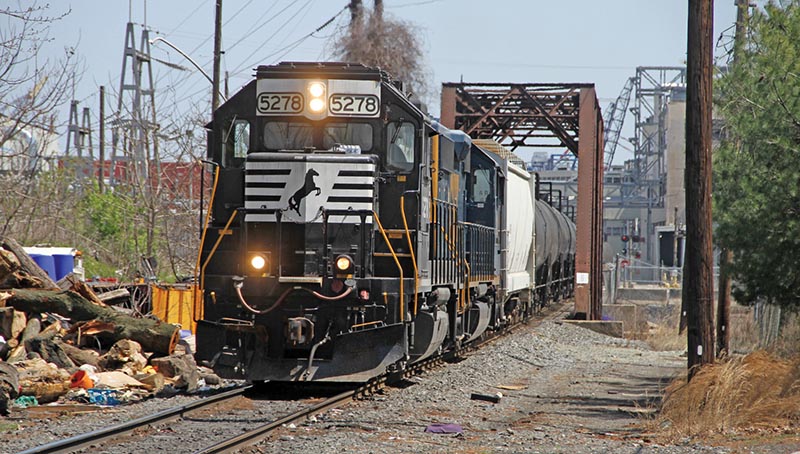
ABOVE: Norfolk Southern GP38-2 5278 leads a tank car consist through the Ridley Creek truss bridge into Chester on April 22, 2022. The train will soon enter Stoney Creek Yard. —Olev Taremae
On April 1, 1976, Conrail came into possession of the Reading trackage as well the former PRR trackage which at this point was operated by Penn Central. Before and during Conrail’s operation of the lines between 1976 and 1999, many of the industries closed, leaving fewer shippers to be served. Conrail rationalized the two roughly parallel sets of tracks into a single set of tracks by abandoning extraneous segments. The resulting track is a mixture of former PRR and Reading tracks. Conrail ferried cars to and from the line from Allentown Yard using trains ALSC and SCAL. All things must pass and so did Conrail. With the split-up of Conrail between Norfolk Southern and CSX Transportation in 1999, the Chester Secondary as it had become known by Conrail, was transferred to the South Jersey District of Conrail Shared Assets Operations (CSAO), which operates the line to this day.
CSAO designates the Chester lines as north-south, north being Eastwick. CSAO designates the part of the line from Eastwick (MP 0.0) southwards to a location named Eddy (MP 8.5) (excepting the stretch that it operates over SEPTA owned tracks) as the Chester Secondary. From Eddy southwards to the end of track, the line is known as the Chester Industrial Track (IT).
Tour of the Line
Trains from CSX’s Eastside Yard cross the Schuylkill River and promptly exit the CSX Philadelphia Division at Eastwick interlocking (MP 2.3 of the Philadelphia Division) onto the Chester Secondary. A dead-end road, South 58th Street, crosses the tracks here, providing a non descript wedge photo. The Secondary meets SEPTA’s Airport Line at an interlocking just north of 61st Street, which crosses above the tracks on a bridge. CSAO identifies this location as 60th Street South. While on SEPTA, CSAO Chester Secondary trains pass through SEPTA’s Eastwick station, where the platform provides access for photography. Just south of the station, the Chester Secondary begins to parallel PA Route 291, which at this point is named Bartram Avenue. Vegetation prevents a clear view of the tracks in this area. The Chester Secondary diverges from SEPTA’s Airport Line and passes under I-95. Route 291 is named Industrial Highway at this point.
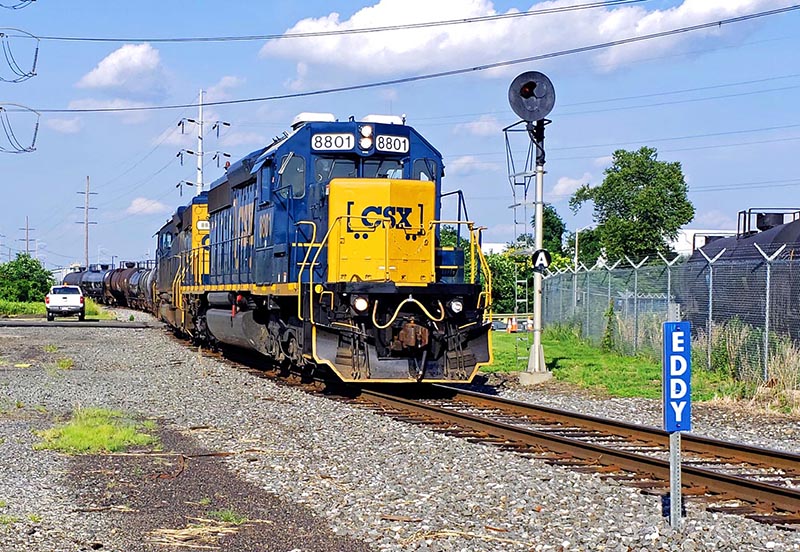
ABOVE: Train SC-21 is southbound on the Chester Secondary with a long string of inbound loads as it approaches “EDDY” block limit, adjacent to the former PECO electrical plant, July 12, 2019. Inbound loaded crude oil tank cars await to be emptied. The signal at right is the advance board for the Darby Creek Draw. South of EDDY, the line is designated as the Chester Industrial Track. —Michael S. Murray OSFS
Lester
Fourth Avenue in the Lester area of Tinicum Township is the next street crossing on the Chester Secondary. Fourth Avenue intersects with both the separated northbound and southbound lanes of Route 291 (which are named North and South Governor Printz Boulevard here), which function as a one-way lanes separated by one block. A dragging equipment detector is located at MP 6.45, between Lester (MP 6.1) and Essington.
Essington
Better shots are available in nearby Essington, at its three railroad crossings – the entrance to Alli Fabrication, Jansen Avenue, and Wanamaker Avenue. Photographs can be taken at each of these crossings.
A switch at Jansen Avenue leads to several shippers. However, the connection to the several-mile-long 60th Street Industrial Track, which circled the Philadelphia International Airport on its south side, tunneled under a runway, and paralleled Hog Island Road, has been severed. This branch once served the tank farms of the now-closed Philadelphia Refinery.
West of Jansen Avenue in Essington, the two separated portions of Route 291 rejoin and are named Industrial Highway once again. CSAO trains work the small Wanamaker Yard, just west of Wanamaker Avenue. In Essington, the Chester Secondary track alignment diverges from the former Reading right-of-way onto the former PRR roadbed…


